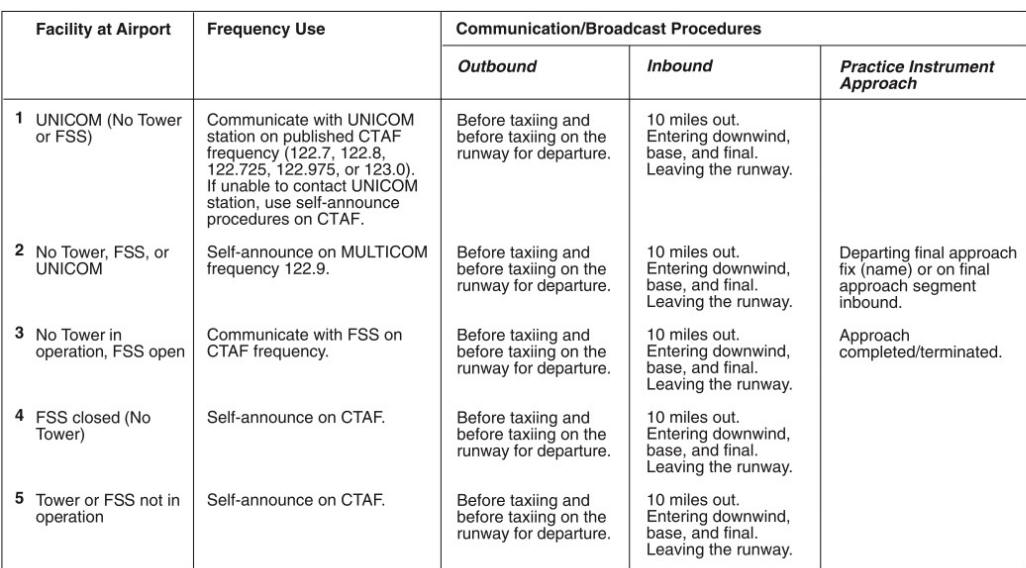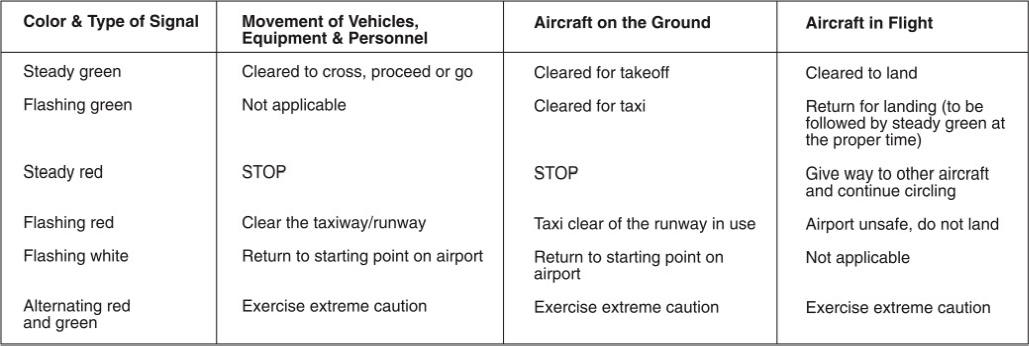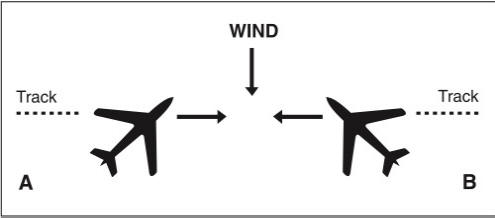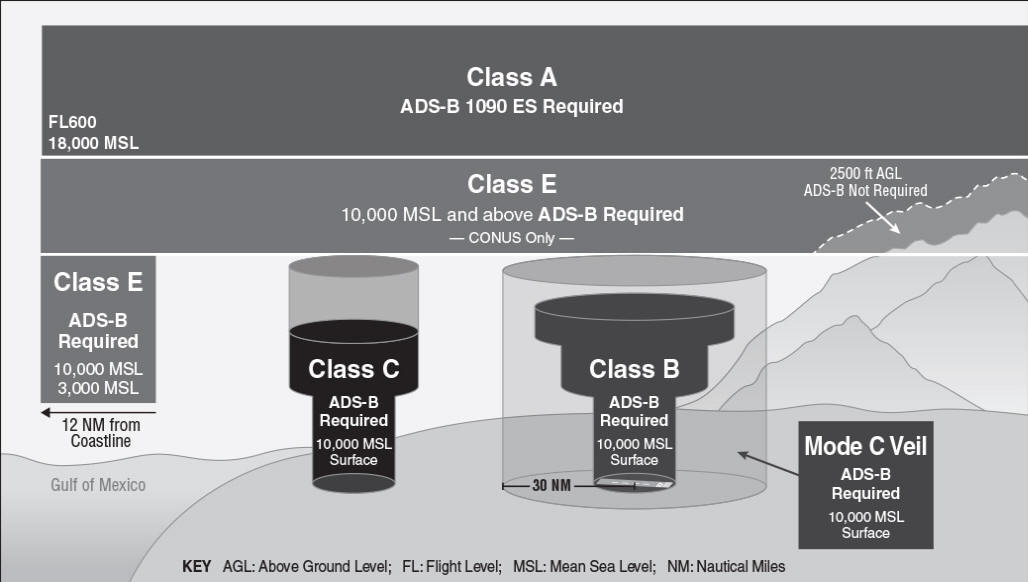|
Aircraft
and Human Performance |
Aircraft Systems
|
| Basic
Aerodynamics |
Communication Procedures |
Enroute Flight |
|
Flight Instruments
|
Navigation |
Procedures and Airport Operations |
| Regulations | Weather | Weather Services | First Aid & Physiology |
Communication Procedures
Table of Contents
Phraseology, Techniques, and ProceduresAirport Traffic Area Communications and Light Signals
Flight Plans
Radar Assistance to VFR Aircraft
Transponder and ADS-B Requirements
Emergency Locator Transmitter (ELT)
Phraseology, Techniques, and Procedures
Automatic Terminal Information Service (ATIS) is a continuous broadcast of non-control information in selected high-activity terminal areas. To relieve frequency congestion, pilots are urged to listen to ATIS, and on initial contact, to advise controllers that the information has been received by repeating the alphabetical code word appended to the broadcast. For example: “information Sierra received.” The phrase “have numbers” does not indicate receipt of the ATIS broadcast.
When transmitting an altitude to ATC (up to but not including 18,000 feet MSL), state the separate digits of the thousands, plus the hundreds. For example, 13,500 is “one three thousand five hundred” and 4,500 is “four thousand five hundred.”
At airports with operating air traffic control towers (ATCT), approval must be obtained prior to moving an aircraft onto the movement area. Ground control frequencies are provided to reduce congestion on the tower frequency. They are used for issuance of taxi information, clearances and other necessary contacts. If instructed by ground control to “taxi to” a particular runway, the pilot must stop prior to crossing any runway. A clearance must be obtained prior to crossing any runway.
Aircraft arriving at an airport where a control tower is in operation should not change to ground control frequency until directed to do so by ATC.
The key to operating at an airport without an operating control tower is selection of the correct Common Traffic Advisory Frequency (CTAF). The CTAF is identified in appropriate aeronautical publications and on the sectional chart. If the airport has a part-time ATCT, the CTAF is usually a tower frequency. If an FSS is located on the airport, they will usually monitor that frequency and provide advisories when the tower is closed. Where there is no tower or FSS, UNICOM, (if available) is usually the CTAF. UNICOM is limited to the necessities of safe and expeditious operation of private aircraft pertaining to runways and wind conditions, types of fuel available, weather, and dispatching. Secondarily, communications may be transmitted concerning ground transportation, food, lodging and services available during transit. When no tower, FSS, or UNICOM is available, use MULTICOM frequency 122.9 for self-announce procedures. See Figure 11-1.

For communications with Flight Service Stations, if you are in doubt as to what frequency to use, 122.2 MHz is assigned to the majority of FSSs as a common en route simplex frequency
Airport Traffic Area Communications and Light Signals
Unless otherwise authorized, aircraft are required to maintain two-way radio communication with the ATCT when operating to, from, or on the controlled airport, regardless of the weather. If radio contact cannot be maintained, ATC will direct traffic by means of light gun signals as shown in Figure 11-2.

If the aircraft radios fail while inbound to a tower-controlled airport, the pilot should remain outside or above the airport traffic area until the direction and flow of traffic has been determined and then join the airport traffic pattern and watch the tower for light signals.
The general warning signal (alternating red and green) may be followed by any other signal. For example, while on final approach for landing, an alternating red and green light followed by a flashing red light is received from the control tower. Under these circumstances, the pilot should abandon the approach, realizing the airport is unsafe for landing.
Flight Plans
Filing a flight plan is not required by regulations; however, it is a good operating practice, since the information contained in the flight plan can be used in search and rescue in the event of an emergency. When completing a flight plan, use the planned cruising altitude in hundreds of feet for the first or the whole portion of the route to be flown expressed as “A” followed by three figures: A075 for 7,500 feet MSL.
Radar Assistance to VFR Aircraft
Radar-equipped ATC facilities provide traffic advisories and limited vectoring (called basic radar service) to VFR aircraft, provided the aircraft can communicate with the facility, is within radar coverage, and can be radar-identified.
Stage II service provides radar advisories and sequencing for VFR aircraft. Arriving aircraft should initiate contact with approach control. Approach control will assume Stage II service is requested, unless the pilot states that the service is not wanted. Pilots of departing VFR aircraft should request Stage II terminal radar advisory service from ground control on initial contact.
At some locations Stage III service has been established to provide separation between all participating VFR aircraft and all IFR aircraft in the terminal radar service area (TRSA). Unless the pilot states “negative Stage III” on initial contact with approach control, the service will be provided.
Traffic advisories given by a radar service will refer to the other aircraft by azimuth in terms of the 12‑hour clock, with twelve o’clock being the direction of flight (track), not aircraft heading. Each hour is equal to 30°. For example, an aircraft heading 090° is advised of traffic at the three o’clock position. The pilot should look 90° to the right of the direction of flight, or to the south. In Figure 11-3, traffic information would be issued to the pilot of aircraft A as twelve o’clock. The actual position of the traffic as seen by the pilot of aircraft A would be two o’clock. Traffic information issued to aircraft B would also be given as twelve o’clock, but in this case, the pilot of B would see traffic at ten o’clock.

These radar programs are not to be interpreted as relieving pilots of their responsibilities to see and avoid other traffic operating in basic VFR weather conditions, to maintain appropriate terrain and obstruction clearance, or to remain in weather conditions equal to or better than the minimum required by FAA regulations. Whenever compliance with an assigned route, heading, and/or altitude is likely to compromise pilot responsibilities respecting terrain, obstruction clearance, and weather minimums, the controller should be so advised and a revised clearance or instruction obtained.
Transponder and ADS-B Requirements
A transponder is an airborne radar beacon transmitter-receiver that automatically receives signals from a ground-based radar beacon transmitter-receiver (interrogator). The transponder selectively replies (with a specific code) only to interrogations received on the mode to which it is set. Civil Mode A transponders have 4,096 discrete four-digit codes. This return signal is displayed on a radarscope on the ground, which a controller can then identify and pinpoint the position of each aircraft (target) under his or her control.
Additionally, some Mode A transponders are equipped with an automatic altitude reporting capability. This system converts aircraft altitude (in 100-foot increments) to coded digital information which is transmitted back to the interrogating radar system. Mode C transponders have this same altitude reporting capability, giving the controller information on the aircraft’s altitude as well as its position. The transponder “Ident” feature should not be activated unless requested by ATC. Activating it will show a blip on a radar screen allowing the controller to quickly locate your position. Mode C, which should be operated at all times, unless ATC requests otherwise, is also required for all flights above 10,000 feet MSL.
The transponder code for VFR flight is 1200. When changing transponder codes, avoid inadvertent selection of codes 7500 (hijack), 7600 (lost communications), 7700 (emergency), and 7777 (military interceptor operations).
If ATC advises that radar service is being terminated, the transponder should be set to code 1200 for VFR flight.
As of January 1, 2020, aircraft operating in airspace previously requiring the use of a transponder will be required to have an Automatic Dependent Surveillance–Broadcast (ADS-B) system that includes a certified position source capable of meeting requirements defined in 14 CFR §91.227. For altitudes below FL180, this system can be either a 1090-ES or Universal Access Transceiver (UAT).
ADS-B Out is a function of an aircraft’s avionics that periodically broadcasts the aircraft’s three-dimnesional position and velocity along with additional identifying information prescribed by §91.227. If the aircraft is equipped with ADS-B Out, it must be operated in transmit mode at all time. The following airspace requires the use of ADS-B Out:
• Class A;
• Class B, from the surface to 10,000 feet MSL including the airspace from portions of Class B that extend beyond the Mode C Veil up to 10,000 feet MSL;
• Class C, from the surface up to 4,000 feet MSL including the airspace above the horizontal boundary up to 10,000 feet MSL;
• Class E, above 10,000 feet MSL over the 48 states and Washington, D.C., excluding airspace at and below 2,500 feet AGL, and over the Gulf of Mexico at and above 3,000 feet MSL within 12 NM of the coastline of the United States; and
• Within a Mode C Veil, the airspace within a 30 NM radius of any airport listed in Part 91, Appendix D, Section 1, from the surface up to 10,000 feet MSL.

Aircraft that were not originally certificated with an electrical system, such as balloons and gliders, are exempt from operations requiring ADS-B Out in certain specified airspace:
• Outside any Class B or Class C airspace area; and
• Below the altitude of the ceiling of a Class B or Class C airspace area designated for an airport, or 10,000 feet MSL—whichever is lower.
Operations of aircraft with inoperable ADS-B equipment are allowed as long as an ATC authorized deviation has been approved by the ATC facility that has jurisdiction over the airspace. These requests can be made at any time.
Emergency Locator Transmitter (ELT)
ELTs have been developed as a means of locating downed aircraft. Transmitting on 406 MHz, the ELT will operate continuously for at least 48 hours.
To prevent false alarms, the ELT should be tested only during the first 5 minutes after any hour and only for one to three sweeps. False alarms can also be minimized by monitoring 406 MHz prior to engine shutdown at the end of each flight.
Non-rechargeable batteries used in ELTs must be replaced when 50 percent of their useful life has expired, or when the transmitter has been in use for more than 1 cumulative hour.